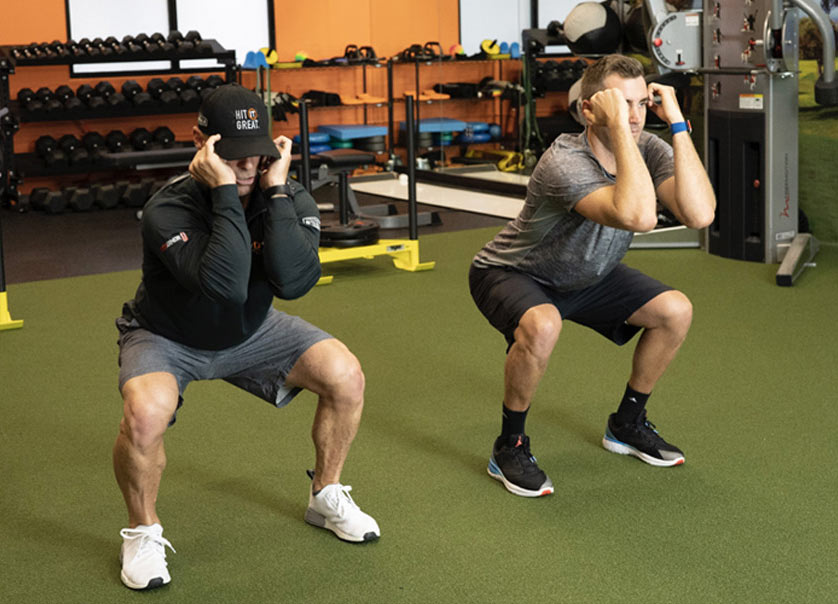
Here’s a scenario for you.
You’ve just split the fairway on the par-4 18th, and you’re ready to cap off a great round. Perhaps, one of the best rounds you’ve played this year. You arrive at your ball and realize you’re in a bit of a pickle: the fairway slopes hard from left to right and you have an extreme side hill lie with a long iron for your second shot.
All of a sudden, crossing the finish line became far more daunting.
If you don’t have leg strength and stability (generated from your workouts), this shot is going to be difficult. And, if we’re being honest, amateur golfers find themselves in uneven or unstable lies or stances more often than the pros–so this is an important exercise for body strength, specifically leg strength and your lower body.
When those parts of your body are strong, there’s no lie or stance you won’t be ready for. To train for this, we enlisted the help of Coach Travis. We won’t be diving right into the deep end, so don’t worry; this series of three squat exercises will gradually build strength and train for that stability we’re looking for.
Let’s get started.
1. Heels-Elevated Goblet Squat
Alright, we’ll consider this Step One.
To improve lower body strength and have more endurance throughout your round, it’s going to be a climb to the final exercise. With this heels-elevated squat, we’re going to start in a stable two-feet position.
In the later exercises, we’ll build stability and strength by using one leg–but for now, we’re beginning in the most stable position. You can use weights if you want (it’s completely up to you), in one hand or both. If you’re using a weight in one hand, make sure you alternate hands for each set.
A couple of things to keep in mind as you’re working through this exercise: first, always make sure you’re allowing your knees to move forward as you get into the squad. Then, try to remain in a tall posture and keep your chest up as you go through it.
One exercise down, two to go. If you’ve mastered this squat exercise, you’re going to enjoy what’s coming up next.
2. Split Squat
We told you we’re going to gradually decrease stability as the exercises get more challenging. Here we go!
For this squat exercise, we’re going to start in a slightly less stable position (see the video for a bit of visual assistance). This exercise is great for hip mobility, which is particularly beneficial for golf because of how often unstable and uneven surfaces come into play. The best way to prepare for what happens on the golf course is by preparing in the gym!
To properly get into this workout, all you have to do is start with a wider base for more stability. The more narrow your base is, the less stable you’ll be. Feel free to, like in the previous exercise, add weights to one or both hands.
One of the best things about this exercise is that there are a number of ways to regress and progress through your reps.
Feeling good, feeling confident? We knew you would. Now it’s time to graduate to the third and final squat exercise.
3. Single Leg Squat
You may have guessed it, but this exercise contains the most unstable position. We’re trying to really build that lower body strength and increase our mobility, which is going to pay off when those uneven or challenging situations arise on the golf course.
Specifically, here, we’re focused on ankle mobility and ankle stability.
A helpful hint: doing this exercise with TRX straps is beneficial for most people so they can replicate the feeling of instability. In a single-leg stance, allow yourself to drop through the squat and push back up, but keep in mind that you don’t want to use the TRX as a row or a prop.
As we move through the workout, this will translate to a two-leg position, which is the position we’re in during a golf swing.
This is hard, but it’s worth it. Strength and stability on the golf course will help your body be ready for whatever the course throws your way.

What Are Squats Doing for My Golf Game?
Allow Coach Travis to explain what these exercises are going to do for you.
“With this instability, you’re going to have this on the golf course with unstable surfaces,” he says. “Any time you can train this in the gym, it’s going to be very helpful. Think about side hill lies, downhill lies. Or you’re unlucky and the ball is at the lip of a bunker – you have one leg in, one leg out of the bunker. If you can’t stay stable with something like this, how can you do it with a challenging or unstable lie?”
Want to stop falling over when swinging from an unstable lie? Have more endurance throughout your rounds? Check out Coach Joey D's book, Fix Your Body, Fix Your Swing, for specific, easy-to-follow exercises that will help you correct your swing mechanics naturally. Also, be sure to order your copy of his brand new book, Hang the Banner, co-written by our very own Coach K-Wayne Tullier! Inside, you'll find a Tour-proven training program based on three 30-minute workouts per week -- straight from the minds of two of golf's most sought-after fitness coaches.

